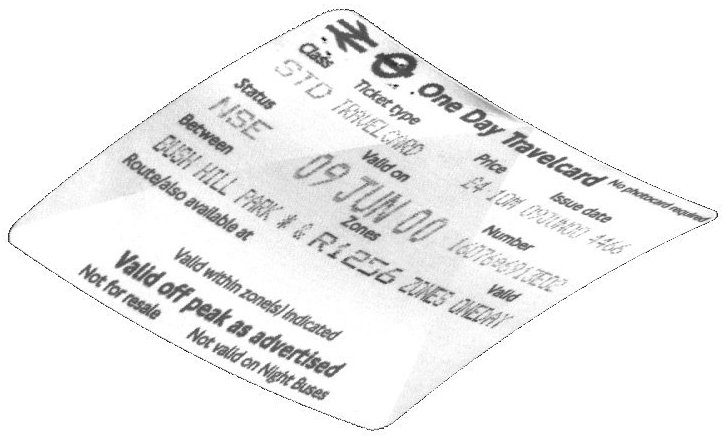Step 1: I’m all cut up!
- Choose a poem - any poem you like. Make a photocopy of it. If it’s a long poem, select just a small part - about half a page, or less.
- Take the photocopy and a pair of scissors. Cut the poem into bits! Yes, you read that correctly! Cut it up - line by line, or phrase by phrase, or into separate words. Or try a mix of all of these.
- Now put all the pieces in a bag. Shake it up.
- Pull the pieces out of the bag, one by one, at random. Like raffle tickets. Don’t peek!
- As you pull each piece out, arrange it on a flat surface to build a new ‘poem’. (Keep clear of fans, doors and open windows!) Lay down the pieces in exactly the same order as they come out of the bag. All you decide is where each line ends, and the next line begins.
- Don’t worry if it seems like ‘nonsense’. Just enjoy watching your new ‘poem’ grow, piece by piece. You can stop any time you like. And you don’t have to use ALL the pieces in the bag.
- When you do decide to stop, quickly copy the poem out on a new sheet of paper (neatly). This is important. You don’t want a gust of wind to ruin everything you’ve done! Then put the pieces back in the bag - you’ll need them again later.
Step 2: Your Results.
- Look at the new poem you’ve made. What weird or unusual things are going on?
- Does it worry you that the grammar is all wrong, or that some bits don’t make any sense?
- Do you think certain bits are more interesting than the original poem? Why/ why not?
- Discuss these issues with your classmates, teacher or a parent.
Step 3: Have another go?
- Shake up the bag (with all the pieces in it) and repeat the exercise. Is the result very different?
- Do you think it’s a good idea to try again, or even a few more times? Why/ why not?
- Do you wish you’d chosen a different poem, or cut it up in a different way? Why? (This is a difficult question, so discuss it with your teacher if you’re stuck).
Step 4: Be an editor.
- Now, tip ALL your pieces carefully onto the table. Rearrange them into a new poem. This time you’re an ‘editor’, because you decide how the bits should be arranged. It’s not random.
- Don’t be afraid to play around with the words - try out different things.
- Do you prefer to be an editor? Or do you think the exercise worked better when the words were picked at random? Look at other people’s results for clues.
_______________________________________________________________________________________________________
Taken from "The Stamina of Sheep"


Underground
(Hornchurch Tube, District Line)
I let him pass. His one liquid word - Cheers.
Under the cloth cap, a face creased and canyoned
as if decompressed from a taut brown moon.
In his voice, a throttle - war-weathered, grown
over-ripe in allotments. Our carriage, dead-beat
towards dark. If we spoke would I have to pause
in the vanguard and turn, offer him words one at a time
like manageable steps? But here, by his boot
- a ticket. Face-down, too fresh. Its single
magnetic stripe, black on white, crisply private.
I picture a turnstile. Him. Far from attention, short
of breath as he frisks himself pocket by pocket,
searches for explanations, his look fixed on flint
somewhere down there the rest of us can't see.
I bend, get a thumbnail under an edge. You might
need this. His eyes narrow to gun-slits. No,
son. Ain't me that needs it. He palms off
the dust. Hands it back. That ticket's yours.
 Finger-post 1
Finger-post 1
- This poem tells a story about two people and how they met. What happened, exactly?
- Where did the incident take place? Does the poem tell you a lot about the place? Does this matter? Why/ why not?
 Finger-post 2
Finger-post 2
- Underline bits of the poem that tell you something about the two people involved. Use a different colour for each person. Try to create a ‘character profile’ for them both.
- What is the relationship between them at the start? How does it change?
- What do you think the older man did when he was younger? What clues are there in the poem?
- Write down one or two phrases from the poem that you like. Also, copy out any lines you don’t quite understand. Are there bits you don’t understand, but like anyway? Why?
- Why do you think the poet makes such a fuss about this minor incident?
 Finger-post 3
Finger-post 3
For this exercise it sometimes helps to work in groups, or as a class.
- Think of examples of films, books and songs where two people meet. Make a list.
- Share your ideas. Create a master list on the blackboard.
- Now rearrange the master list into types of story: love stories, humour, ghost stories, fantasy, etc.
- Working on your own, choose one type of story from the board (say, fantasy). Invent a new story, of your own, that fits this type. There are two conditions:
(1) you are only allowed two characters;
(2) there should be some kind of encounter between them. Write your story down.
Click here to find out about Mario's residency in Havering and "The Stamina of Sheep"
FURTHER INFORMATION
&
BOOKINGS
copyright mario petrucci
2001




 Finger-post 1
Finger-post 1 Finger-post 2
Finger-post 2 Finger-post 3
Finger-post 3